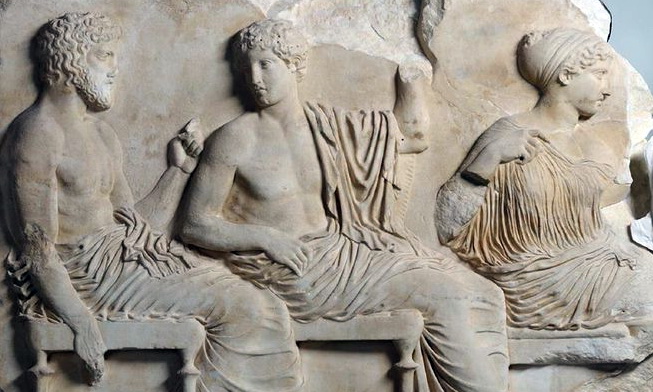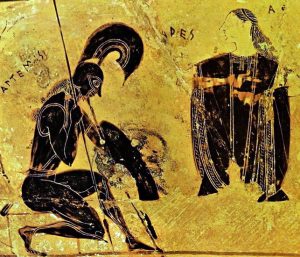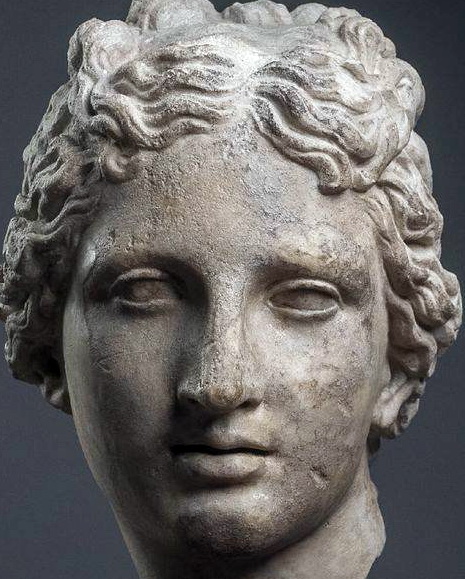Aphrodite (Venus)
Aphrodite is the Olympian goddess of love, beauty, sexual pleasure, and fertility.
Aphrodite’s Birth

Aprodite was born from sea foam and was flirtatious and enticing as such. As told in Hesiod’s Theogony, Aphrodite, who came about from the seeds of Uranus that poured into the sea, was drifted by waves to the Island of Cyprus in an oyster shell. Aphrodite’s name is usually linked to the Ancient Greek word for “sea-foam,” aphros, which fits nicely with the story of her birth. However, modern scholars think that both Aphrodite and her name predate Ancient Greece. According to the former, Aphrodite was the daughter of Zeus and the Titaness Diona, thus making her a second-generation goddess, much like the most Olympians. Aphrodite was thus born out of the blue waters of the Mediterranean. This child of Mediterranean soon took her place in Greece as a goddess. According to Homer, on the other hand, Aphrodite was born from Dione, the daughter of Zeus and Oceanus.
Aphrodite’s Role
The goddess of love was also recognized by different names such as Ishtar by the Assyrains and Astarte by the Phoenicians. She was also honoured as a goddess

of war, especially at Sparta, Thebes, Cyprus, and other places. This gorgeous being took her part in Olympus as a goddess symbolizing beauty, grace and fertility, surrounded by the Charites and Horae. she was known primarily as a goddess of love and fertility and even occasionally presided over marriage. Although prostitutes considered Aphrodite their patron, her public cult was generally solemn and even austere.
Aphrodite enlivened nature which spread out love to hearts. It was accepted that her helping hand influenced every beauty in blooming nature. And her son Eros, who shot arrows of love into hearts and whom sh bore from Hermes, would never leave her side.
Loves of Goddess
Aphrodite and Adonis
Aphrodite lay with Ares the god of war, and from this union forth Phobos (fear), Deimos (dread) and Harmonia /harmony). Aphrodite also lay with Adonis (in origin a Semitic nature deity and the consort of Ishtar-Astarte), the son of the King Cyprus. The King had a strikingly beautiful daughter named Myrrha, and her mother claimed that she was more beautiful than Aphrodite. In responce, Aphrodite cursed Myrrha by making her fall in love with her own father and sleep with him. When he discovered the situation, the King wanted to kill daughter but the gods spared her by transforming her into a myrtle tree. Thus Adonis was arisen from this myrtle tree. Nymphs, the fairies of nature, looked after the newborn, who eventually became a handsome young man. One fine day, Eros erroneously shot his mother Aphrodite with the arrow of love and the arrow made her fall in love with Adonis desperately. However, their love did not last ver long because Adonis was killed a boar while hunting. The cult of Adonis had underworld features, and Aphrodite was also connected with the dead at Delphi.
Aphrodite and Hermes
Aphrodite lay with Hermes and this union produced the androgynous Hermaphroditus. One day, Hermaphroditus wanted to take a bath in the Bardakçi Cove from

Bodrum. A girl named Salmacis saw him there and was struck by him. She jumped into the water and embraced this young man. When she was refused bu him, she pleaded with the gods and wished not be parted with him. He wish was granted and she became a part of him: Hermaphroditus was transformed into an androgynous being now. Aphrodite’s union with Dionysus brought forth Priapus, who was a bizzare being with his huge male genital.
Aphrodite Married to Hephaestus
Aphrodite, who was chosen as the most beautiful goddess on Mount Ida by Paris, was eventually given in marriage to the lame god Hephaestus.Aphrodite did not love her husband, the lame god of blacksmiths. The account of her infidelity to her husband with Ares and their captivation by Hephaestus in a golden net is told in Homer’s Odyssey. She also lay with Anchises of Dardania, from the royal lineage of Troy, and gave birth to the famed Aeneas. After the devastation of Troy, Aeneas was the one who brought the survivors to Rome.
Beautiful, flirtatious and enticing as she was, the anger, resentment and vengeance of the goddess was much dreaded as well. When they stirred her anger, she would afflict the women of Lemnos with such odor that their husbands would no longer approach their wives. In some instances, the goddess would plague the women zrousing her anger with such lust that they would feel compelled to lie with whomever comes along. This would continue until her anger subsided.
Aphrodite was surrounded by the Charites, who symbolized beauty, grace and fertility, namely whateever appealed to the eye. Charis means beauty and glamour. The Cahrites were goddess which speaks spread joy and happiness to the hearts of gods and people. These goddesses were born d-from Eurynome the goddess of harmony, who was the daughter of Zeus and Oceanus. They were also known as the Tree Graces and were named Aglaea, Euphrosyne and Thalia. Other deities around Aphrodite were the Horae, and the Hymenaeuses who would leave wedding processions. Aphrodite and Cupid initiated the love between Jason (hero of the Quest of the Golden Fleece) and the daughter of the Colchian King.
In Art
Praxiteles the sculptor created two statues of Aphrodite around 350 BC. One of them is a nıde deciption, while the other is clothed. The nüde one was taken by the city of Knidos on the coast of the Mediterranean and erected the town center. Antique author wrote about sailors setting sale to the Anatolian coasts to see this most beautiful statue of the world. When the people of Knidos went into great debt during the first century BC. Nicomedes II claimed this statue in return fort his loan; however, people of Knidos paid every penny of their debt but did not give their sculpture. Ancient historians wrote that this sculpture was brought to the Palace of Lausus in Constantinople during the Byzantine times and was consumed in flames when the palace burnt. Decipting a nüde goddess fort he first time, Praxiteles showed in this sculpture all the beauty, charm and curves of womanhood. The clothed version of the Aphrodite sculpture was taken by the people of Cos (Island of İstanköy) and erected in their city. Praxiteles also cast a sculpture of Aphrodite in half-clothed form, which is known as the Aphrodite of Arles. In a divine beauty contest judged by Paris, in which Aphrodite competed against Athena and Hera to win the golden apple, Aphrodite offered to give paris the most beautiful woman on earth, Helen, and thus won the conquest. She kept her promise by having beautiful Helen enamored of Paris. Aphrodite was accepted as goddess of love in Greece and Rome; whereas in Anatolia, she was a goddess symbolizng fertility. In Aphrodisias, where she was a chief deity, Aphrodite did not only symbolize of beauty; her multiple-breasted form was the symbol of fertility. She came to be identified with Cybele, the fertility goddess of Anatolia. A marvelous temple was built for Aphrodite in Aphrodisias. This temple is still standing today with 14 columns, arousing admirations in onlookers. Constructed in the Late Hellenistic period, the temple was surrounded by a temenos during the reign of Hadrianus (AD 117-138). The tetraphyion, which was built on the path leading to the temple, has been restored and re-erected today, setting an impressive disğlay. Many head statues of Aphrodite were found during the excavations of Aphrodisias. These head statues, excelling one another in beauty, can be seen today at the Aphrodisias Museum today.

Artistic representations of Aphrodite usually render her as coming out of a sea shell. With her beautiful hair, innocent face and proportionate body, she became a source pf inspiration to sculptors in decipting an ideal woman body. The birth of Venus is a painting by Sandro Botticelli that features Aphrodite. The source text of this art work is though to have been written by the Latin poet Ovid.
Plants and fruits devoted to her were myrtle tree, opium popy, apple, pomegranate, and rose. Her sacred birds were sparrow and pigeon. Animals devoted to her were goat, oyster, dolphin and tortoise. She was revered as Venus in Rome. Early on the Archaic art, Aphrodite was decipted as fully clothed, sometimes seated but mostly standing. From the 5th century BC onwards, some parts of her body began to be revealed. During the Hellenistic period, when nudity predominated, she was mostly shown as naked while stepping out of sea or bath.
Aphrodite of Alcamenes, which dates to the 5th century and is in the Louvre Museum today, shows her with a light tulle on her body. The Roman-era copy of Aphrodite Genetrix sculptered by Callimachus around the 5th century BC is in the Louvre Museum, while the Roman copies of the Aphrodite of Knidos, created by Praxiteles as nüde, can be seen in the Vatican and many other museums. Half-clothed Aphrodite by Praxiteles, which is presently at the Louvre Museum, is a Roman copy of Aphrodite of Arles.
The most famous of the sculptures recovered to date is half-naked Aphrodite created by Lysippos on the Island of Melos. Discovered among theatre ruins on Melos, the 2nd century BC, sculpture is at the Louvre Museum today. This is why half-clothed sculptures of Aphrodite are known as Aphrodite of Melos.
Medici Venus by Kleomenes, dating to the 1st century BC, was found in Florence and is another half-nude Roman copy. There is also the Capuan Venus from the 4th century at the Therme Museum in Rome, as well as Roman copy of Aphrodite Knidos created by Praxiteles in 350 BC, which is in the Vatican Museum.
A Roman copy of the Capitoline Venus dating to 320 BC and illustrating Aphrodite as coming out of bath, is in the Capitoline Museums today.
There are many sculptures of Aphrodite in Turkish Museums too. The terracota Aphrodite of Knidos in the Çanakkale Museum is one of them. Sculptures of Aphrodite can also be seen in museums such as İstanbul Arcaheology, Antalya, Aphrodisias and İzmir.
Sources
Few poems are more beautiful than Lucretius’ invocation of Aphrodite at the beginning of “On the Nature of Things.” Compare this to the longest of the three Homeric Hymns dedicated to Aphrodite, the 5th one. Finally, Aphrodite is a constant companion of Aeneas in Virgil’s “Aeneid.”

